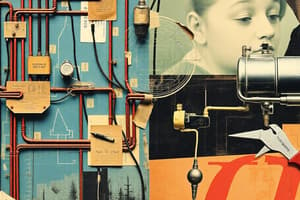Podcast
Questions and Answers
Which electrical component serves as the primary point for connecting or splicing wires within a system?
Which electrical component serves as the primary point for connecting or splicing wires within a system?
- Utility box
- Fuse panel
- Junction box (correct)
- Convenience outlet
If an electrical circuit experiences a sudden overload, which device is designed to automatically interrupt the current flow to prevent damage?
If an electrical circuit experiences a sudden overload, which device is designed to automatically interrupt the current flow to prevent damage?
- Connector
- Fuse (correct)
- Switch
- Clamp
Which of the following materials is designed to encase and protect electrical wires, offering insulation and mechanical protection?
Which of the following materials is designed to encase and protect electrical wires, offering insulation and mechanical protection?
- Adapters
- Clamps
- Connectors
- Conduits (correct)
In a temporary wiring setup, such as an extension cord, what type of wire is commonly used, typically available in rolls of 150 meters?
In a temporary wiring setup, such as an extension cord, what type of wire is commonly used, typically available in rolls of 150 meters?
What is the primary function of a convenience outlet in an electrical circuit?
What is the primary function of a convenience outlet in an electrical circuit?
Which device is used to switch on or off the electrical supply in a circuit?
Which device is used to switch on or off the electrical supply in a circuit?
What is the purpose of a clamp in electrical installations?
What is the purpose of a clamp in electrical installations?
Which tool is specifically designed for fastening or unfastening screws?
Which tool is specifically designed for fastening or unfastening screws?
Flashcards
Utility box
Utility box
Rectangular box for attaching outlets/switches.
Male plug
Male plug
Device inserted into an outlet to conduct current.
Fuse
Fuse
Protects circuits by blowing when overloaded.
Junction box
Junction box
Signup and view all the flashcards
Conduits
Conduits
Signup and view all the flashcards
Circuit breaker
Circuit breaker
Signup and view all the flashcards
Switches
Switches
Signup and view all the flashcards
Convenience outlet
Convenience outlet
Signup and view all the flashcards
Study Notes
- Study notes on electrical tools and their functions
Electrical Materials
- Utility Box: Metallic or plastic (PVC) rectangular box for attaching flush-type convenience outlets and switches.
- Connectors/Adapters: Connects various electrical components.
- Male Plug: Device inserted into a convenience outlet to conduct electric current.
- Fuse: A circuit protection device that automatically blows and cuts the current during an overload or short circuit.
- Junction Box: An octagonal electrical box, either metal or plastic (PVC), used for wire connections or splices and attaching flush-type lamp holders.
- Conduits: Electrical materials that protect and insulate wires; types include rigid metallic, flexible metallic (FMC), rigid nonmetallic (PVC), and flexible non-metallic or corrugated plastic (CPC).
- Circuit Breaker: A protective device that automatically blows and cuts the current when there's a short circuit or overload.
- Electrical Wires: Wires or cords that provide a path for electric current to flow.
- Lamp Sockets / Holders: Devices that hold and protect lamps; come in flush, hanging, and surface types.
- Fuse Panel / Safety Switch: Immediately turns off the electric supply when a fault is detected.
- Switches: Devices that connect and disconnect electric current flow in a circuit; various shapes, designs, and types exist (hanging, flush, and surface types).
- Convenience Outlet: Acts as a source of electricity where the male plug is inserted; comes in single, duplex, triplex, and multiplex types.
- Clamps: Electrical material used to hold and anchor electrical conduits in position.
- Connectors: Used to attach metallic or non-metallic conduits to junction or utility boxes.
- Flat Cord: A duplex stranded wire for temporary wiring, typically used in extension cords; comes in 150-meter rolls in gauge #18 and #16 AWG (American wire gauge).
Electrical Tools
- Screwdrivers: Steel tools hardened and tempered at the tip for loosening or tightening screws with slotted heads; available in various sizes and shapes.
- Hammers: Tools for pounding, driving, and pulling out nails; made of hard steel, wood, plastic, or rubber.
- Pliers: Metal tools with insulated handles for holding, twisting, bending, cutting, and gripping wires and cables.
- Wire Stripper: Removes insulation from medium-sized wires, ranging from gauge #10 to gauge #16.
- Electrician's Knife: Used to remove insulation from wires and cables in low and high-voltage transmission lines.
- Portable Electric Drill: A small drilling machine with a chuck capacity of ¼‖ to 3/8‖, used for making holes in metal sheets and concrete walls
- Hacksaw: Tool used to cut metal conduits and armored cables.
Studying That Suits You
Use AI to generate personalized quizzes and flashcards to suit your learning preferences.




